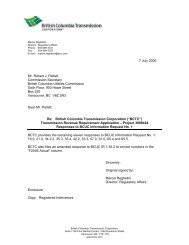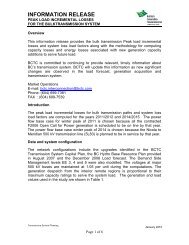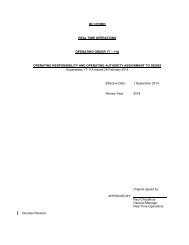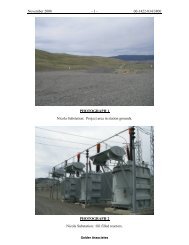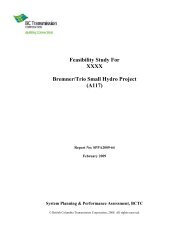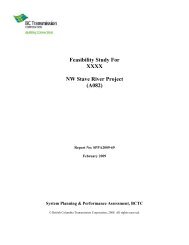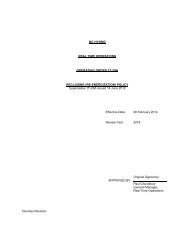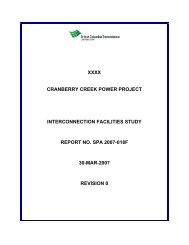Evidence on the Adequacy of First Nations Consultation - BC Hydro ...
Evidence on the Adequacy of First Nations Consultation - BC Hydro ...
Evidence on the Adequacy of First Nations Consultation - BC Hydro ...
You also want an ePaper? Increase the reach of your titles
YUMPU automatically turns print PDFs into web optimized ePapers that Google loves.
<strong>the</strong> Tobacco Plains area for three more years 31 , ga<strong>the</strong>ring informati<strong>on</strong>. Their route through <strong>the</strong><br />
Rockies appears to have been through Howse Pass 32 and was described by Fidler: 33<br />
In going out <strong>the</strong>y crossed over <strong>the</strong> Mountain near <strong>the</strong> Source <strong>of</strong> <strong>the</strong> Saskatchewan in an oblique<br />
directi<strong>on</strong> <strong>the</strong> latter place was more easy to pass than <strong>the</strong> former across <strong>the</strong> Mountain. Bey<strong>on</strong>d <strong>the</strong><br />
Mountain opposite to <strong>the</strong> head <strong>of</strong> <strong>the</strong> Saskatchewan a thick woody country – <strong>the</strong>y passed thro’ it al<strong>on</strong>g<br />
an old Track formerly cut by <strong>the</strong> Cott<strong>on</strong>ahaws, being <strong>the</strong> Nor<strong>the</strong>rn most track <strong>the</strong>y have; it was now<br />
very troublesome to pass thro’ it <strong>on</strong> account <strong>of</strong> <strong>the</strong> l<strong>on</strong>g time <strong>the</strong>y have not passed that way, being much<br />
encumbred with Wind fall wood &c.<br />
Following <strong>the</strong> path <strong>of</strong> his deputies La Gasse and LeBlanc over Howse Pass, David Thomps<strong>on</strong> finally<br />
crossed <strong>the</strong> Rockies in 1807, seeking to trade directly with <strong>the</strong> Ktunaxa and to explore a route<br />
westward to <strong>the</strong> sea. He so<strong>on</strong> realized that <strong>the</strong>re were two distinct groupings <strong>of</strong> Ktunaxa, <strong>the</strong> Upper<br />
and Lower “Kootenai”, 34 which reflected <strong>the</strong>ir relative positi<strong>on</strong>s <strong>on</strong> <strong>the</strong> Columbia and Kootenay<br />
Rivers and different occupati<strong>on</strong>al emphasis. The Upper Ktunaxa <strong>the</strong>y found to be more active traders<br />
with an orientati<strong>on</strong> toward horses and <strong>the</strong> plains buffalo hunt which <strong>the</strong>y pursued with regular<br />
seas<strong>on</strong>ality. The Lower Ktunaxa, whom Thomps<strong>on</strong> describes in his Journals as “Lake” Indians and<br />
later traders named “Flatbows” 35 , were found to be less active in this regard, with more orientati<strong>on</strong><br />
toward boats and fisheries <strong>of</strong> <strong>the</strong> territory’s lakes and rivers. Despite <strong>the</strong>se differences in <strong>the</strong>ir<br />
respective ec<strong>on</strong>omies, Thomps<strong>on</strong> <strong>of</strong>ten found <strong>the</strong>m encamped toge<strong>the</strong>r. 36<br />
In that first summer <strong>of</strong> 1807, Thomps<strong>on</strong> established, as noted previously, a trading post called<br />
Kootenae House, just north <strong>of</strong> present day Invermere, and spent much <strong>of</strong> <strong>the</strong> next four years<br />
exploring <strong>the</strong> Columbia Plateau, including residing <strong>the</strong>re during <strong>the</strong> winters <strong>of</strong> 1807-1808 and 1808-<br />
1809. Unfortunately, Thomps<strong>on</strong> was not much <strong>of</strong> an ethnographer and nei<strong>the</strong>r his Journals nor his<br />
later Narrative provide much illuminati<strong>on</strong> in <strong>the</strong> way <strong>of</strong> delineating aboriginal territory particularly<br />
with respect to <strong>the</strong> subject area <strong>of</strong> this study. Most <strong>of</strong> his travels in <strong>the</strong> area c<strong>on</strong>cerned <strong>the</strong> exploring<br />
<strong>the</strong> Kootenay River system [which he first believed to be <strong>the</strong> Columbia] down into present day states<br />
<strong>of</strong> Washingt<strong>on</strong>, Idaho and M<strong>on</strong>tana, although he made <strong>on</strong>e foray in 1808 to <strong>the</strong> sou<strong>the</strong>rn porti<strong>on</strong> <strong>of</strong><br />
Kootenay Lake, where he encountered a band <strong>of</strong> Lower Ktunaxa. 37 In 1811 he travelled al<strong>on</strong>g what<br />
eventually came to be known by <strong>the</strong> fur brigades as <strong>the</strong> “Columbia Express”, from Jaspers House in<br />
Alberta over <strong>the</strong> Athabaska Pass <strong>the</strong>n down <strong>the</strong> Wood River to Boat Encampment 38 , <strong>the</strong>nce down <strong>the</strong><br />
Columbia in canoes via <strong>the</strong> Arrow Lakes to Fort George at <strong>the</strong> mouth <strong>of</strong> <strong>the</strong> Columbia. His last<br />
travels in <strong>the</strong> regi<strong>on</strong> were around <strong>the</strong> Fla<strong>the</strong>ad Lake area <strong>of</strong> present-day Idaho and M<strong>on</strong>tana in 1812,<br />
after which he performed survey work in eastern Canada.<br />
31 See also Schaeffer, LeBlanc and LeGassé: Predecessors <strong>of</strong> David Thomps<strong>on</strong> in <strong>the</strong> Columbian Plateau.<br />
32 Belyea, Columbia Journals, David Thomps<strong>on</strong>, p. 194<br />
33 H<strong>BC</strong>A E3/2, from Belyea, p. 194. This passage is interesting in that it suggests that <strong>the</strong> Ktunaxa may have been<br />
shifting <strong>the</strong>ir buffalo hunting efforts southward, likely in resp<strong>on</strong>se to <strong>the</strong> effective arming <strong>of</strong> <strong>the</strong>ir enemies east <strong>of</strong> <strong>the</strong><br />
Rockies by fur traders and <strong>the</strong> added protecti<strong>on</strong> afforded by cooperative hunting with <strong>the</strong> more sou<strong>the</strong>rly Fla<strong>the</strong>ad Salish.<br />
34 O<strong>the</strong>r anglicized spellings encountered include Kutenai, Kootanais and Kootenae<br />
35 From <strong>the</strong> shape <strong>of</strong> <strong>the</strong>ir hunting bows. The name may have originated with Quebecois “free” traders who called <strong>the</strong>m<br />
“Arc-des-Plattes”.<br />
36 For example, David Thomps<strong>on</strong>’s Narrative, ed. Burr [p. 388]. This is c<strong>on</strong>sistent with Turney-High, who points out in<br />
his Ethnography <strong>of</strong> <strong>the</strong> Kutenai that such differences should not be over-interpreted as both groups were seen as skilled<br />
hunters and each would visit <strong>the</strong> o<strong>the</strong>r’s regi<strong>on</strong>s for hunting buffalo or fishing for trout and salm<strong>on</strong>.<br />
37 Op cit, p. 386<br />
38 The historic Boat Encampment was <strong>on</strong> <strong>the</strong> right bank <strong>of</strong> <strong>the</strong> Columbia, just below <strong>the</strong> mouths <strong>of</strong> <strong>the</strong> Canoe and Wood<br />
Rivers. The site now lies beneath <strong>the</strong> Kinbasket Reservoir formed by <strong>the</strong> Mica Dam.<br />
17<br />
Page 161 <strong>of</strong> 200






